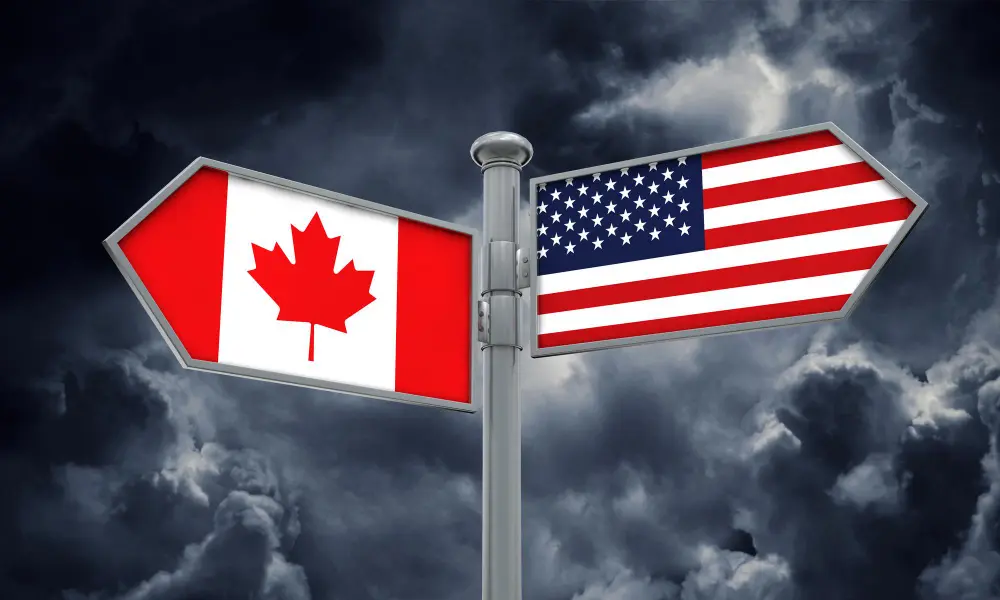
In March 2025, the United States imposed new tariffs on Canadian imports, significantly impacting trade between the two nations. These tariffs include a 25% duty on Canadian goods and a 10% duty on energy exports. The U.S. justifies these actions, citing national security concerns related to illegal immigration and drug trafficking. Furthermore, additional tariffs on steel, aluminum, and the automotive industry are set to take effect by March 12, 2025.
Table of Contents
- Canada-U.S. Trade: A Critical Economic Partnership
- Understanding Import Tariffs: What They Are and How They Impact You
- The Impact of U.S. Tariffs on Canadians and Americans
- Impact on Canadian and U.S. Consumers
- Impact on Canadian and U.S. Businesses
- Impact on Canadian Housing Market
- Canada’s Strategic Response: Countermeasures to U.S. Tariffs
- The Strategic Impact of Canadian Tariffs
- Government Support for Canadian Businesses and Workers
- What’s Next for Canada’s Economy Amidst Trade Tensions?
Canada-U.S. Trade: A Critical Economic Partnership
Canada and the U.S. share one of the largest and most dynamic trade relationships globally, with approximately US$2.5 billion worth of goods and services crossing the border daily. Given the strong economic ties, these tariffs are expected to have significant consequences on both economies.
Understanding Import Tariffs: What They Are and How They Impact You
An import tariff is a tax imposed on goods entering a country. While tariffs serve to protect domestic industries and generate revenue, they also increase the cost of imported goods, affecting both consumers and businesses.
The Impact of U.S. Tariffs on Canadians and Americans
Impact on Canadian and U.S. Consumers
The U.S. tariffs on Canadian imports will lead to higher costs for consumers in both countries. Everyday products such as fuel, groceries, and household items will see price hikes. American manufacturers, reliant on Canadian materials, will also face increased production costs, potentially leading to job losses and reduced competitiveness in the global market. Canadian consumers will also experience the ripple effects of these price hikes on imported goods.
Impact on Canadian and U.S. Businesses
Canadian businesses relying on cross-border trade will face increased costs and logistical challenges. U.S. companies that depend on Canadian exports will see disruptions in their supply chains, increased operational costs, and higher product prices. This may slow economic growth and deter new investments, affecting industries on both sides of the border.
Impact on Canadian Housing Market
The ripple effect of these tariffs extends into the housing market. With inflation rising due to higher goods and service costs, the Bank of Canada may increase interest rates to control inflation. As mortgage rates climb, homeowners will face higher monthly payments, and potential buyers may struggle to afford properties. Construction costs could also rise due to the increased prices of imported materials, further exacerbating the affordability crisis in Canada’s housing market.
Canada’s Strategic Response: Countermeasures to U.S. Tariffs
To counter the U.S. tariffs, Canada introduced countermeasures aimed at applying pressure on the U.S. government to reconsider its tariffs. On March 4, 2025, Canada imposed tariffs on $30 billion worth of U.S. imports, including items such as orange juice, peanut butter, wine, beer, coffee, appliances, apparel, and motorcycles. Canada also plans to levy an additional $125 billion in tariffs on U.S. goods, which will include electric vehicles, trucks, aerospace products, beef, pork, and dairy, subject to a 21-day comment period.
The Strategic Impact of Canadian Tariffs
By imposing tariffs, Canada aims to make U.S. goods more expensive, encouraging consumers to favor Canadian-made products. This action serves as a clear signal to the U.S. government and businesses about the negative impact of unfair tariffs. It also bolsters support for domestic businesses and encourages consumer spending on local products.
Government Support for Canadian Businesses and Workers
To mitigate the effects of these tariffs, the Canadian government has introduced several financial programs designed to support businesses and workers impacted by the tariffs. These include:
- Canada Small Business Financing Program: Helping small businesses secure loans.
- Trade Commissioner Services: Assisting businesses in finding new markets.
- Trade Impact Program: Allocating $5 billion over two years to help exporters navigate challenges.
- Business Development Bank of Canada: Offering $500 million in loans to affected businesses.
- Farm Credit Canada: Providing $1 billion in financing for agriculture and food businesses.
- EI Work-Sharing Program: Supporting workers facing reduced hours.
What’s Next for Canada’s Economy Amidst Trade Tensions?
The newly imposed U.S. tariffs on Canadian imports have created significant economic challenges. However, Canada’s response, including counter-tariffs and targeted financial programs, aims to cushion the economic blow and support domestic growth. As tensions continue, businesses and consumers can take steps to adapt to the evolving trade landscape by prioritizing local goods and services.
In the face of uncertainty, strategic planning and government support can help Canadian businesses remain resilient and ensure long-term economic stability. By staying informed and engaged, Canadians can navigate these economic shifts and contribute to a more resilient and self-sustaining economy.
Check out our latest Make Money Count video on how U.S. tariffs are affecting Canada’s economy and housing market!
If you’re looking to refinance, consolidate debt, or tap into your home’s equity, now is an ideal time to reassess your mortgage strategy. Cannect can structure a solution that not only gives you access to today’s lower rates but also sets you up to capitalize on upcoming changes
















No Comments